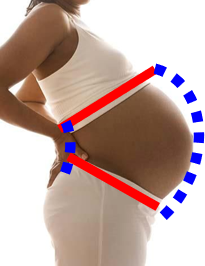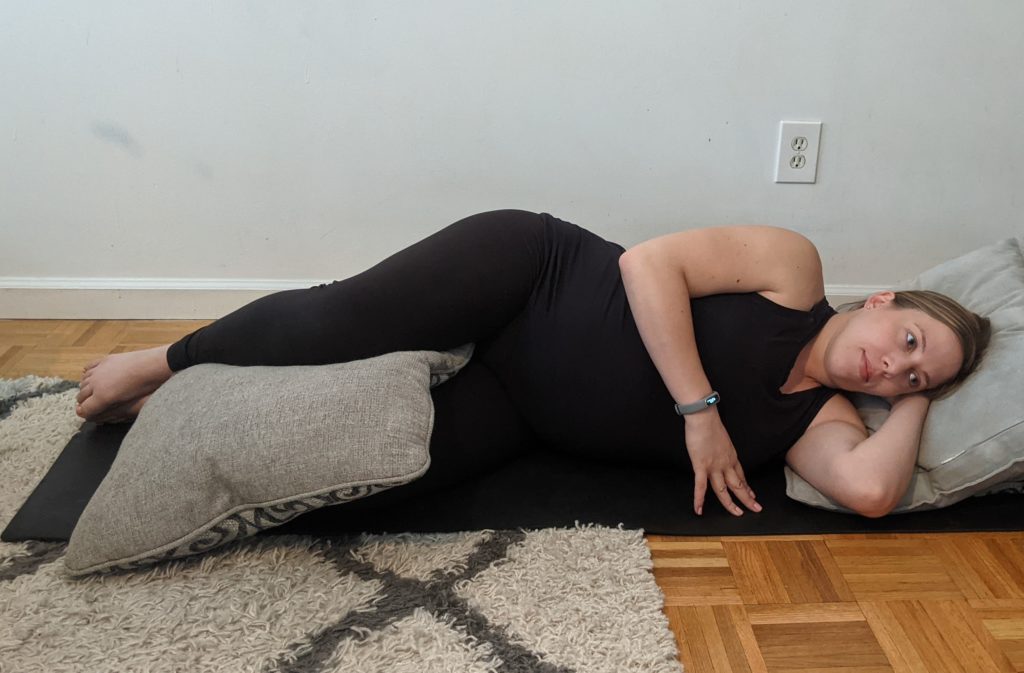“My pregnancy was progressing smoothly until the 4thu month when I started experiencing intermittent, debilitating nerve pain in my left hip when I went for a walk. The pain was so bad I didn’t know how I was going to make it to the store, let alone at the end of my pregnancy. This kind of incident happened several times over a few weeks, but after about a month, I never had any problems again. Such a mystery. I suspect my son had found a comfortable spot, nestled right in front of my lumbar spine, and took a very long nap.”
– Carolyn Appel, Director of Training, ProNatal Fitness.
While there are many aches and pains that your pregnant body can experience as a result of weight gain, alignment changes, and other physiological changes, sciatica can be among the most intense.
Sciatica is not medical diagnosis. Instead, it is the term used to describe irritation of the sciatic nerve. It can appear as numbness, pain or tingling in the back of your hips and buttocks and down each leg. The pain is typically felt on one side and can vary from dull and mild, to sharp and shooting.
Sciatica is sometimes confused with SI joint pain (another common pregnancy “butt pain”), but if you’re feeling numbness and pain radiating down your leg, it’s likely sciatica.
The good news is that, like the example above, the pain can be temporary and only bother you for a limited time during pregnancy.
More good news: there are definitely things you can do to minimize the pain. This will be the focus of this post. First, let’s start with a brief look at what causes sciatica so you can better understand some of the strategies we recommend for treating it.
What causes sciatica
In this diagram, you can see that the sciatic nerve (in blue) exits the lumbar spine and travels down the back of the leg. Therefore, any “trapping” along its path can cause irritation. Some examples of things that could cause this entrapment or irritation in the sciatic nerve are:
- Misalignment of the spine (such as with a herniated disc in the lumbar spine)
- Another possible cause is due to an imbalance in the hip musculature. Muscles can become very tight from overuse and compress the nerve that runs through it. Conversely, if the gluteal muscles are weak due to disuse, the apioid—a deep hip rotator—can overcompensate and compress the sciatic nerve. This latter cause is often referred to as piriformis syndrome.
The most common cause during pregnancy it’s the anterior pelvic tilt from the growing belly. When the pelvis tilts forward, it pulls the lumbar spine forward into excessive low back arch, as you can see in the image below. This can put pressure on the sciatic nerve.

Focus exercises
To relieve sciatic nerve pain, you want to focus on the following two goals:
- Relieve pressure on structures that compress the nerve
- Strengthening of the surrounding structures to increase the stability of the pelvis.
Here are some beneficial exercises to focus on.
1. Focus on neutral alignment: Okay, so this first one isn’t technically an “exercise,” but it is the most important tip focus on minimizing sciatic nerve pain. Spinal misalignment plays a large role in the potential for nerve irritation. So you want to focus on “getting into neutral” to bring better balance to the curves of your spine. Pay close attention to entering your body pelvic neutral, as explained in the video.
2. 360° Breathing: We refer to this as the #1 most effective core exercise. 360° Breathing has numerous benefits, but especially as it relates to sciatica, it helps strengthen your core from the inside out which helps stabilize your hips and pelvis. While this demo is shown seated, this position may not feel right on your hip, so adjust as needed. You could try standing, lying down, on your hands and knees, or any position that reduces your symptoms.
3. Cat Stretch: Posterior pelvic tilt (or rolling your pelvis down, as in the “cat” part of cow-cat) can provide some temporary relief by taking pressure off the sciatic nerve. This stretch is a variation of the cat-cow stretch where you only perform the stretch portion of cat (taking your pelvis down), then return to a neutral spine instead of going into “cow” (arch).
4. Seated Swing Stretch: This is another enjoyable stretch to take pressure off the sciatic nerve. Raise your leg only as far as you can while maintaining neutral alignment (sitting up).
5. License Plate Windshield Wiper: This is another good one for relieving pressure on the sciatic nerve. Hold one side for a few breath cycles.
6. Back Sciatic Thread: This technique is similar to stretching, but helps to gently mobilize the nerve and “unstick” it. Try this for several repetitions. You don’t have to fully straighten your leg. Simply reach your leg to the point where you feel a gentle tension in the back of your leg.
7. Bridge (with optional knee press): Remember that the second goal of our sciatica exercises is to strengthen the surrounding muscles to increase pelvic stability. Your glutes help stabilize your pelvis, and this bridge exercise is a great way to target your glutes. For an added bonus, place a rolled-up towel, partially deflated ball or yoga block between your knees and actively press it while performing your bridges — on the way up and below. This helps strengthen your inner thighs (adductors), which can also reduce stress on your outer hips (remember that overactive hips sometimes contribute to sciatica).
8. Incline Board: Strengthening the front of your core can help lengthen your lumbar spine (key to relieving pressure on the sciatic nerve), while also helping you create and strengthen the neutral pelvic position we discussed in # 1. A plank can be a great exercise for this. Of course, depending on where you are in your pregnancy, it may be necessary modify full boards. Incline planking can be a great option. The key to finding the right plank variation (and degree of incline) for you is that you should be able to execute your plank 1) maintaining neutral alignment and 2) without cones in your belly.
9. Bird Dog: Like the incline plank, this is another great pregnancy-safe core exercise that targets the muscles in the front of your core.
10. Sleep on the “uninjured side:” Well, like #1, our last point isn’t really an “exercise,” but it’s important to note that you may find it more comfortable to sleep on your “good” side. When sleeping on your side, place a pillow between your knees to keep your pelvis in a more neutral alignment. You can also try one warm compress the hot bath for some temporary relief.

Exercises to avoid
The exercises to avoid are very similar to the ones you’re dealing with SI joint pain. These include:
- One leg lower body movements: One-legged weight-bearing movements, such as any kind of walking or stepping up/down, place your pelvis in a less stable position. In general, you want to keep your weight evenly distributed over both legs (think squats and bridges).
- Traditional cardio machines: Machines like the elliptical, Stairmaster, and treadmill all promote single-leg activity, so it’s best to avoid them.
- (Be careful with) daily activities with one leg: Activities such as walking, climbing stairs, and getting up and down from the ground are also activities with one leg. Of course, it’s not possible to completely avoid these activities, and we wouldn’t want you to either. It is important to keep moving. You might just want to cut back prolonged periods of walking or climbing stairs when the pain is severe. Also, when you get up off the ground, get up on the side that doesn’t hurt.
- Effect: When performing any type of impact activity (running, plyometrics, etc.), impact forces travel through the body and can cause more pain. It is best to focus on non-impact movements while symptomatic.
- Any movement that causes pain: This should be obvious, but it’s worth mentioning. Sometimes pain triggers are different for each person, so try to pay attention to the activities that cause pain for you and avoid them.
Additional Support
- If you have painful symptoms, consider wearing a compression garment. We love the range of Health SRC, which offers high-quality clothing to wear under and over your bump (use code PRONATAL10 with a 10% discount.).
- For programs and services to help you exercise safely and effectively during pregnancy, see our educational programs and services.
- If you are a health and fitness professional interested in coaching pre and postnatal clients, explore us ProNatal Training & Certification.
Partner Notification: The post contains an affiliate link for SRC Health. We may earn a commission from purchases made through this link. However, we only endorse companies that we have personally reviewed and trust.
